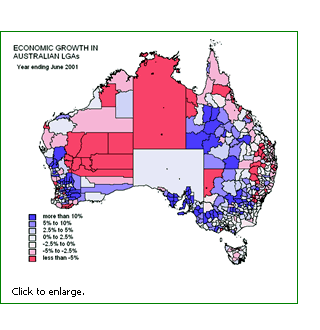Hard data on historical trends in local economic activity is now available directly from the internet. The recent release of a new 20 year database by the Bureau of Transport and Regional Economics (BTRE) provides Local Government with a new tool which will underpin local research and planning and provide insight into each Council’s recent economic history.
The database and associated paper, Information Paper 54, Focus on Regions 3: Taxable Income, provide detailed information on income and economic activity for every Local Government Area (LGA) in Australia from 1980–81 to 2000–01.
BTRE’s Deputy Executive Director, Dr Judith Winternitz, points out that until now, Local Government has had to rely on population or employment figures to gauge their economic progress. Good income based data has only been available every five years through the Census. The BTRE’s annual database is freely available on the Bureau’s website.
State and Local Governments, researchers, business people and regional communities are encouraged to use it in their everyday work.
“We all know that national economic growth is not evenly spread across the regions and this data allows us to understand the different economic growth patterns,” Dr Winternitz said. “This work will help government, private industry and communities pinpoint where differences occur and identify underlying causes.”
The information paper released with the database looks at some trends in the data. It shows that the economies of most Councils tend to move in line with the national economy with some local variation. However other, usually non metropolitan, regions are more dependent on a single industry or commodity. These economies diverge much more from national trends and fluctuate extensively with drought, price or exchange rate movements.
Overall, metropolitan regions tend to have higher growth rates than non metropolitan regions but are also more heavily impacted by international and national economic downturns.
The difference between the LGAs with the highest and lowest income per taxpayer is growing in metropolitan areas, but in non metropolitan Australia, these differences are declining and income is becoming more evenly spread.
Dr Winterniz said the database was drawn from the individual taxable income of regional residents.
For convenience, the figures have been calculated on consistent 2001 Local Government area boundaries and adjusted for the effects of inflation. While the database currently covered the period 1980–81 to 2000–01, it will be regularly updated to reflect new data published by the Australian Taxation Office.
The database builds on earlier BTRE Focus on Regions reports dealing with regional Industry Structure and regional Education, Skills and Qualifications. These publications and their associated databases are available free of charge at www.btre.gov.au








